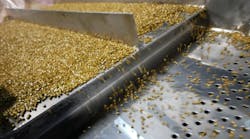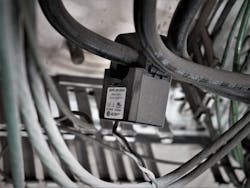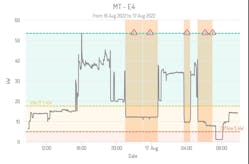At the beginning of 2022, Penn Color Vice President of Operations Bill Scilingo saw the cliff in the distance as the company approached a capacity problem that would limit growth. He decided the company was not going to come anywhere near that precipice.
A medium-sized manufacturer of additives used to color plastics, Doylestown, Pennsylvania-based Penn Color has five plants in the United States and one in The Netherlands. Scilingo is responsible for operational output and metrics and for standardizing the company's continuous improvement programs. He realized that the traditional system the company employed to track downtime events could not provide the accurate OEE data he wanted, largely owing to how much time it took operators to report incidents.
“Our focus here is getting to what we call operator-led continuous improvement, where we want our operators focusing on how to improve the operation, not entering data,” Scilingo says.
The solution lay with a simple IoT system that led to Penn Color finding itself with significant room for growth rather than approaching the wall of maximum capacity.
Tried Does Not Mean True
Penn Color’s business involves color matching and custom additive batches, necessitating frequent line changeovers and creating thousands of active part numbers. Understanding why OT assets go down and accurate OEE measurement allow the shop to remain nimble.
In the company’s traditional downtime reporting system, if a machine went down, operators would have to record—from memory—when the downtime event began and ended. Operators might combine multiple downtime events, like routine maintenance followed by an equipment malfunction shortly thereafter, into a single event. Inconsistent application of reason codes, or explanations for the downtime, further muddled the data. Operators also had to duplicate the same information onto a paper record.
Material planning analysts would later take 24 hours’ worth of data, pulled in part from the paper records and often requiring validation with the operators who recorded the data, collate it into spreadsheets and calculate uptime/OEE. Operational insights always lagged events.
Data also tracked operators, not the machines they ran, therefore the system calculated operator efficiency rather than machine efficiency.
“If a changeover took an hour, and that was the standard in the traditional system, that would be okay, that operator was efficient. It took him an hour, it was expected to take an hour,” says Scilingo. “But [the system] didn’t take into account that machine was down for an hour. Someone had to manually go in and recalculate all that uptime. Because, again, it was a person uptime system, not an equipment uptime system.”
Operators might forget to log some downtime events or inaccurately recall how long the events took place, or group multiple downtime events under a single error code when there were actually multiple, different explanations for separate events. Discrepancies required clarification by operators. The system, clunky at best, needed replacement.
Finding the Right IoT Solution
The company knew it wanted to move in the direction of a better, IoT-based solution. Scilingo evaluated half a dozen options, looking for a system adaptable to Penn Color's needs.
“What we found, and the reason we didn’t go with [other options] was they were pretty set in how things happen. They had their solution, this is the way it works, weren’t very customizable to our downtime events, our business,” Scilingo says.
The IoT evaluation plan dictated piloting the solution at one of Penn Color’s two plants at its Hatfield, Pennsylvania, location, but plant managers from all the American plants were also part of the discussion, in recognition of the ultimate goal to come up with a standard IoT solution for all Penn Color facilities.
“There was some skepticism of what the new system was going to give us because it was off our traditional way of viewing things, going away from tracking the efficiency of a person to tracking the efficiency of an asset,” says Scilingo.
The Guidewheel system installed at Penn Color consists of off-the-shelf sensors that clip onto power cords and connect to hub devices that hook into the plant's IT network via ethernet cabling. When a sensor detects a downtime event, back-end software running on the cloud records when the event begins and ends. Operators later access the downtime event in the software and add a reason code.
Operators in some cases need to walk to a centralized location on the production floor to interact with the software, but Penn Color has also installed terminals directly at some of the OT assets and intends to do so for the majority of assets at its plants.
It took around two to three weeks to physically install the system, a simple operation according to Scilingo that only got tricky for machines located in explosion-hazard cells.
Accurately Tracking OEE with Superior Downtime Data
Scilingo says it took another two to three weeks to gather enough data to have a baseline for the pilot facility.
“When we started getting our first data, there was a lot of, ‘Well, this can’t be right,’ because it didn’t match the traditional data,” Scilingo says. “Our uptime was less than we expected. The approach there was, listen, this isn’t a club. This is a tool to make us better and give us an idea of what our opportunity is [to improve] in our plant.”
The trustworthiness of data captured by the new system gradually became clear. Material planning analysts took handwritten reports from the traditional system and reports from the IoT system onto the floor to ask operators whether they remembered specific events. The operators often agreed that the IoT system provided more accurate data.
Scilingo says it took operators about two months to fully accept the new system. They appreciated that the data, displayed on visual management boards within different areas of the plant and/or monitors stationed at individual OT assets, organizes by team performance, not individual performance.
Access to the data created more empathy between operators, as they could see when co-workers had mechanical issues with specific machines and how that impacted productivity, rather than simply blaming co-workers if tasks weren’t completed between shifts. Operators could review the data captured during their shift and pass notes to workers on the following shift about potential issues to keep watch for.
It took analysts another month, says Scilingo, to really understand the opportunities presented by the new system. Rather than spending their time scrutinizing data, analysts could spend more time using data to improve planning processes and uptime. They more became problem solvers and less number crunchers.
“The backend [software] puts that [data] into a Pareto analysis and generates the data for us, so now we’re looking at analysis of data, not specific downtime events, and saying okay, where do we most effectively utilize our resources?” says Scilingo. “Where’s our biggest opportunity here to improve the process?”
Scilingo wishes he’d been able to make clear early on that using an automated system to provide reports like Pareto analyses didn’t mean replacing the data analysts’ jobs. It meant giving them a tool to get more involved with other aspects of their jobs and contribute even more to company improvement.
”I think that was an oversight on my part. Absolutely. I think that’s something [about] the introduction of this technology that I missed early on, and I learned on. That’s something that needs to be done up front, that needs to be explained,” Scilingo says.
Increased Plant Capacity Means Doing More Business
In Q1 2022, when deciding where to focus their efforts for the pilot program, Scilingo chose one particular subset of OT assets that Penn Color had identified as constraining capacity the most. After four months of operational data post-Guidewheel installation and the opportunity to better manage asset usage, uptime on that equipment increased by 50%.
Penn Color then expanded the scope of the IoT project in Q2 to include not only other types of equipment in the pilot plant but also the second plant located at the Hatfield facility. The company also by Q3 had deployed the IoT system in the rest of its U.S. plants.
”We’ve been able to eliminate legacy pieces of equipment that were very underutilized and sometimes very specialized on a product [we could] get to run on another piece of equipment. So we’ve seen about a 3% reduction in maintenance cost, based on not maintaining equipment that we really don’t need.”
Scilingo believes that, thanks to the installation of the Guidewheel system, Penn Color can get another 30% to 35% utilization out of the equipment at its U.S. plants, allowing the company to hold steady and work at 75% to 80% capacity, maintaining the ability to smoothly tackle large-volume one-off orders while still accounting for capacity requirements to support anticipated year-on-year growth.
“We’re at a point right now that we feel comfortable not only meeting that projected growth increase, which is more of a strategic market penetration, but we’ve also been able to take on more spot business, because we have that available capacity,” Scilingo says. “And we're not up against that capacity standpoint. We’re much more comfortable now having those discussions when those opportunities come in. In the past, it was a lot of scrambling to make sure we could do it. Now, our commercial group has a green light to go after those type of opportunities.”






